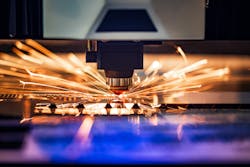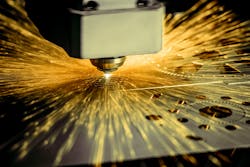MARTIN BAILEY
The purchase of a new fiber laser is not an insignificant one, yet companies will often overlook the relatively inexpensive cost of appropriate computer-aided design (CAD)/computer-aided manufacturing (CAM) and nesting software that could get significantly better performance out of their investment. This article presents techniques that can squeeze more performance out of a computer numerically controlled (CNC) laser machine.
CAD/CAM and nesting software may have either been supplied alongside a machine or a company may have sourced a system to drive multiple brands and cutting types. Either way, companies may not necessarily be getting the best performance out of their machines.
A component starts life in CAD, perhaps either as a single entity or part of a more-complex assembly. Next, it needs to go through the CAM process, with cutting technology applied based on the CNC machine to be used, followed by the creation of a nest of one or more components. It is during these two processes that advanced technologies can be applied to reduce runtime and wear on the machine, as well as improve the quality of the finished part.
Cutting methods
Common cutting is one of the most common ways to improve efficiency. This is the process of eliminating the skeleton between parts, separating them instead with a single cut. Not only can this save material and consumables, it can also significantly reduce the machine runtime. However, when performing common cutting, there are other considerations to take into account, such as sheet stability on machines with a fixed head and intelligent cutting of notches at the adjacent component edges.
If components often contain arrays of holes such as air vents, then fly cutting, also referred to as grid cutting, can drastically reduce cutting time. This is only relevant for users of machines that will support this functionality. Also, this technique is only suitable for thinner materials.
Fly cutting works by software analyzing the nest, identifying grids and lines of holes, and then splitting the cutting into separate short line or arc segments that lie on the same line or circle. In other words, with a grid of, say, 10 × 10 rectangular holes, the beam might start top left and move the head horizontally, cutting the top-most part of the holes by rapidly switching the beam on and off as it travels between them. Then, as it travels off the grid to the next line of cuts, a radius can be placed on the path, meaning that the laser does not have to stop the head movement completely in order to change direction, reducing machine wear. It will continue to ‘snake’ through all horizontal cuts until it reaches the bottom row, after which it will move onto the vertical cuts. Fly cutting will reduce cutting time dramatically and, if a CAM system is capable enough, can actually be used to cut the whole nest when lead-ins/leadouts are not necessary.
Of course, fly cutting, as with common cutting, can bring the risk of collision, so this must be used in conjunction with intelligent path optimization and crash avoidance. As the final cuts are performed on a grid being fly-cut, each slug will be free-floating and could tip, posing a crash hazard.
Fly cutting or not, a company’s software needs to be intelligent enough to ensure that the head will avoid any areas posing a crash hazard throughout the whole cutting process and on nests of any complexity.
The logic behind these processes is extremely complex, and in order to be flexible enough to automatically deal with different machines and technologies, materials, and thicknesses, the software must allow the user a high degree of configurability.
Nesting software considerations
Path optimization in general can itself yield reductions in machine runtime. Although factors such as avoidance of already-cut areas may add to the overall travel time, it will pay for itself many times over in avoiding expensive head crashes and subsequent downtime. On thick materials, in addition to optimizing the path taken, one can also minimize the number of times that the laser must pierce the sheet. Chain cutting creates a single pierce and then will continue to cut components, moving from one to the next with an overrun. Optimizing the position of lead-ins will further reduce travel time.
Mentioned above, and an important part of path optimization, intelligent tangential rounded movements between holes—which allow for smooth and continuous changes of direction—can also speed up the cutting process while eliminating machine stresses, reducing the maintenance costs and machine downtime.
For those regularly cutting assemblies of pre-nested components, mosaic nesting can often provide a quick hit in terms of saving time. Mosaic nesting is essentially “nesting of nests”—for example, creating a static nest of a particular assembly of parts and then adding that to an existing nest, often by literally dragging and dropping it onto the sheet. A further benefit of this is when an individual component is updated, the mosaic nest and any additional nests that contain that part would be updated automatically, ensuring that the correct revision of a part is always cut.When it comes to cutting thicker material, there are other considerations that come into play. Cutting a nest of complex parts can cause a buildup of heat in a small, concentrated area, which may lead to significant inaccuracies in component dimensions. Heat avoidance logic can be applied to automatically start cutting in a different area of the sheet after concentrated cutting has occurred in one area, thus eliminating buildup of potentially damaging amounts of heat. A predetermined zone can be automatically created around the area, along with a cooling period. As the material is cooling in one area, the laser will move to another part of the sheet in order to continue cutting.
A good example of how multiple technologies can be combined to deliver quantifiable savings is I-Cherng Refrigeration, based in Taiwan. The company had been using JETCAM Expert to drive various punch and laser CNCs since 1995. Now, the company uses a combination of JET-Cut fly cutting, advanced path optimization, and common cutting, which produced a machine cycle time reduction of 13.2% and improved material yield up to 30%. Integration to the company’s ERP system allowed parts to be imported, tooled, and nested within minutes, reducing overall programming time by 80%.
Calculating ROI of nesting software
It may be that the parts you manufacture lend themselves to one or all of the above-mentioned methodologies. When trying to calculate the return on investment on software that might deliver this functionality, there are three key areas that allow one to quantify potential savings—material, manpower, and machine. Material consumption is the quickest to calculate—if a company is saving an average of 5% on an annual spend of $1 million a year, then that’s a savings of $50,000. Savings on manpower and machine runtime are a little trickier to calculate, but an estimate of hours per week can be multiplied by known machine and staff hourly rates to yield an approximate figure.
Of course, the Holy Grail is true automation. If these technologies can be applied fully automatically, it not only drastically reduces programming time, but makes the job itself far less complex to remove the possibility for human error and allow other staff to cover the role that previously only skilled programmers could cover.
Summary
Companies often balk at the perceived high cost of CAM/nesting software, but it can be insignificant when compared against the cost of a laser. Yet, it is the software that produces the electronic fuel for this machinery in the form of NC code. Get it wrong and a company’s staff will spend time generating programs, the laser machine will not be performing its best, and a company will be spending more on material. Get it right and staff will be more productive, the company will be more competitive, and, through automation, de-skill the nesting process altogether.
MARTIN BAILEY ([email protected]) is the General Manager of Jetcam International s.a.r.l., Monaco; www.jetcam.com.

